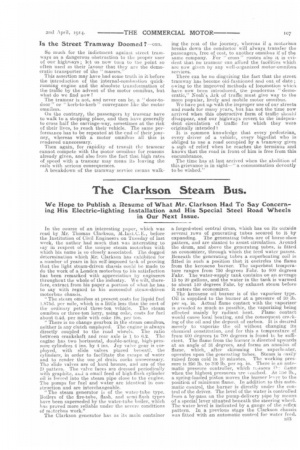The Clarkson Steam Bus.
Page 5

If you've noticed an error in this article please click here to report it so we can fix it.
We Hope to Publish a Resume of What Mr. Clarkson Had To Say Concerning His Electric–lighting Installation and His Special Steel Road Wheels in Our Next Issue.
In the course of an interesting paper, which was read by Mr. Thomas Clarkson, eLlnet.C.E., before the Institution of Civil Engineers on Tuesday of last week, the author had much that was interesting to say in respect of the unique steam. motorbus with which his name is so closely associated. The dogged determination which Mr. elaakson has exhibited for a number of years in his self-imposed task of proving that the light steam-driven chassis could be made to do the work of a London motorbus to his satisfaction has been remarked with appreciation by engineers throughout the whole of the industry. We will, therefore, extract from his paper a portion of what he has to say with regard to his successful steam-driven motorbus chassis.
" The steam omnibus at present costs for liquid fuel i_875d. per mile, which is it little less than the cost of the ordinary petrol three-ton vehicle. The steam omnibus or three-ton lorry, using coke, costs for fuel about 0.4d. per mile with coke 19s. per ton. "There is no change gearbox in the steam omnibus, neither is any clutch employed. The engine is always directly coupled to the road wheels. The ratio between crankshaft and roar axle is I to 6.2. The engine has two horizontal, double-acting, high-pressure cylinders 4 ins. by 4 ins.. Joy valve gear ie erre ployed, with slide valves placed beneath the cylinders, in order to facilitate the escape of water and to render the use of drain cocks unnecessary. The. slide valves are of hard bronze, and are of the I) pattern. The valve faces are dressed periodically with graphite, and a small feed of high-flash cylinder oil ie forced into the steam pipe close to the engine. The pumps for fuel and water are identical in construction and are interchangeable.
"The steam generator is of the water-tube type. Boilers of the fire-tube, flash, and semi-flash types have been superseded by the water-tube boiler, which has proved more reliable under the severe conditions of metorbus work."
The Clarkson generator has as its main container
a forged-steel central drum, which has on its outside several rows of generating tubes secured to it by expanding. The .generating tubes are of horse-shoo pattern, and are slanted to assist circulation. Around the drum, and above the generating tubes, is fitted an economizer, through which the Iced water Passes. Beneath the generating tubes a superheating coil is fitted in such a position that it encircles the flame from the kerosene burner. The -superheat temperature ranges from 750 degrees Fehr. to 800 degrees Fehr. The water-supply tank contains on an average 15 to 20 gallons, and the water in the tank is warmed to about 140 degrees Fehr. by exhaust steam before it enters the economizer.
The kerosene oil burner is of the vaporizer type. Oil is supplied to the burner at a pressure of 30 lb. per sq. in Actual flame contact with the vaporizer is avoided as much as possible, the vaporizing being effected mainly by radiant heat. Flame contact would cause local heating, and the consequent creaking of the oil and the deposit. of carbon. It is desired merely to vaporize the oil without changing its chemical constitution, and for this a. temperature of from 000 degrees to 700 degrees is found to be sufficient. The flame from the burner is directed upwards at an angle of 31 degrees, and forms: an annulus of flame, which, after skimming the superheater, operates upon the generating tubes. Steam is easily raised from cold in 10 minutes. The working pressure is 250 lb. to :300 lb. per ,sq. in. There ie an automatic pressure controller, which reduces ths fiame when the highest pressures ere emitted. At euie lb., a spring-loaded piston moves the burner leseir to the position of minimum flame. In addition to this automatic control, the burner is directly under the control of the driver. The level of tha water is controlled from a by-pass on the pump-delivery pipe by means of a special lever situated beneath the steering wheel. The water level is indicated by a gauge of the reflex pattern. In a previous stage the Clarkson chassis was fitted with an automatic control for water feed.






















